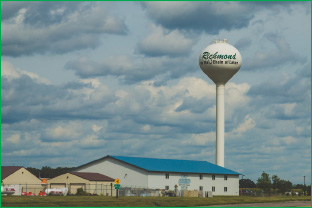Reeds Against Phosphorous to Meet Minnesota Standards
Operator Chad Johnson Takes on Phosphorous in Richmond, Minnesota
 Richmond, Minnesota, is a beautiful city located at the heart of the Horseshoe Chain of Lakes, just 25 minutes west of St. Cloud. Home to River Lake Days and a center for water recreation, Richmond draws tourists from all over the Midwest to take advantage of the many amenities found there. Understandably, Minnesota prizes its lakes and stands by some of the strictest phosphorus limits in the nation. Phosphorous is a growing problem in wastewater due to increased use of household products that contain it.
Richmond, Minnesota, is a beautiful city located at the heart of the Horseshoe Chain of Lakes, just 25 minutes west of St. Cloud. Home to River Lake Days and a center for water recreation, Richmond draws tourists from all over the Midwest to take advantage of the many amenities found there. Understandably, Minnesota prizes its lakes and stands by some of the strictest phosphorus limits in the nation. Phosphorous is a growing problem in wastewater due to increased use of household products that contain it.
Chad Johnson is our operator who runs the city’s water and wastewater facilities. “Serving more than 1,400 people, what we do is vital,” he said. “Our mission is to do whatever it takes to ensure that Richmond’s water supply is clean and safe and that the wastewater returned to the environment is ecologically safe. Of course it is paramount to comply with the state’s requirements and ensure operations run cost-effectively and at peak efficiency.”
A Servant of the Community
Chad began his career with PeopleService in Richmond nearly seven years ago, but his roots in the community go back further. A student of water/wastewater at St. Cloud Community College, Chad went on to get his licensure. A self-described “jack-of-all-trades,” Chad has what it takes to succeed in this industry. “As an operator, I’m a mechanic, an electrician, a biologist, chemist and so many other things depending on the day,” he added.
“I’ve worked for a small town running their pond system and today I operate the Richmond wastewater treatment facility – an oxidation ditch with extended aeration. It also uses the reed bed system to filter phosphorous out of the sludge.”
Constructed reed beds remove phosphorus by plant uptake, assimilation by microorganisms and physical-chemical processes, sorption by soil and precipitation reactions. As most of our operators, Chad knows reed bed system technology well. As Chad put it, “It’s an effective system, and one that presents different challenges with changing seasons. When it’s cold, the reeds are inactive. When it’s hot, as in late August and September, you have to shut the air off to the bio-feed system to trick the “bugs” into consuming the excess phosphorus.”


